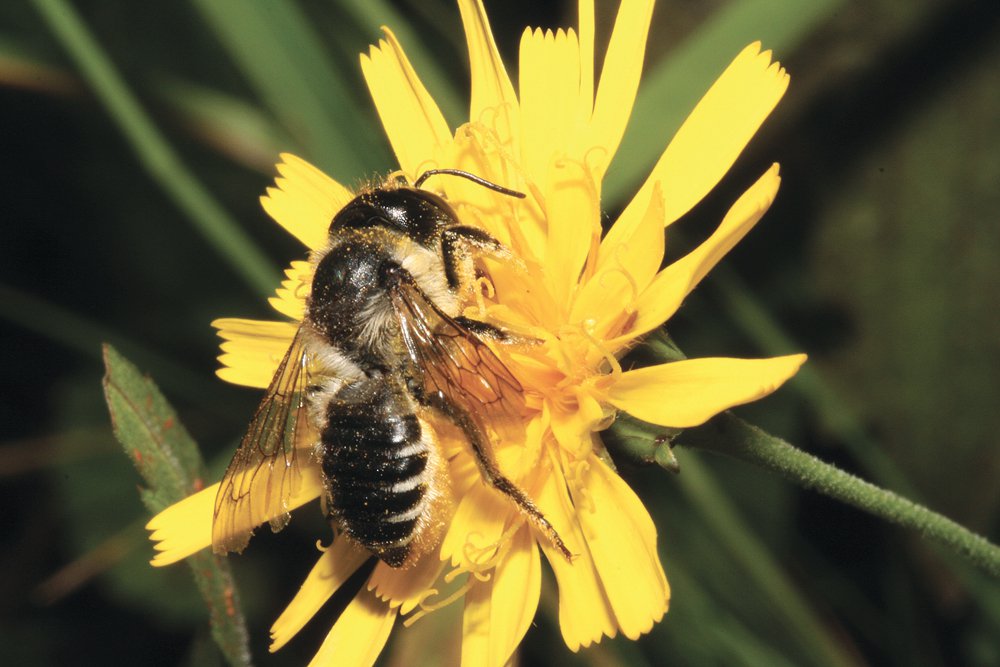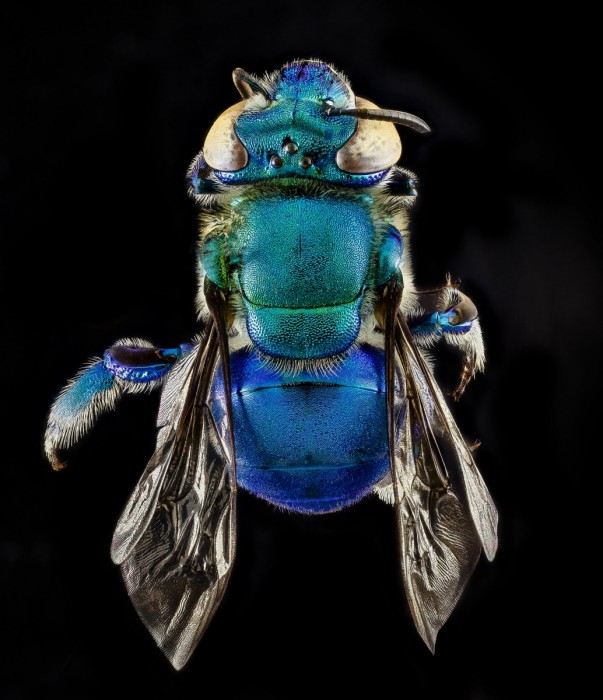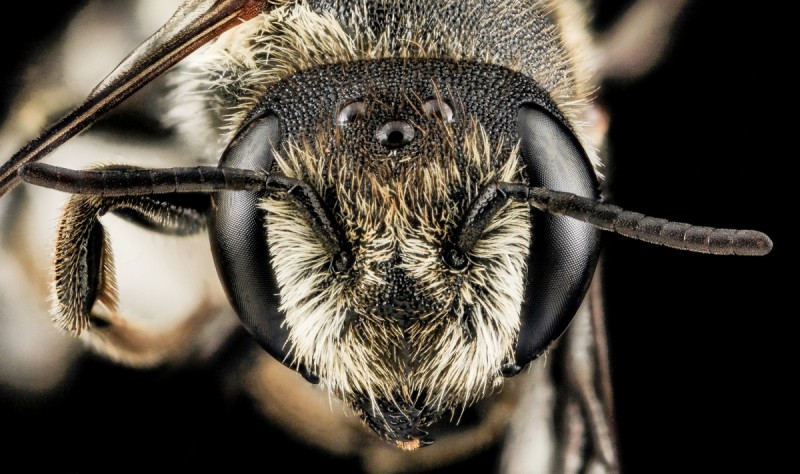
Solitary nesting bees, like this native leafcutter bee, will benefit from a U of M competition. // Photo: Pat Mackay, Senior Scholar, U of M
Bee Q&A
On March 31, the University of Manitoba opens an international design competition that will challenges creative minds to rethink houses for nesting bees. Why do bees need our architects and designers? We talked to professor Robert Currie, head of entomology and renowned bee researchers, to learn why bees need new houses.
UM Today: What are tunnel nesting bees and why should people care?
Professor Robert Currie: Tunnel nesting bees are solitary species of bees that are mostly native to Manitoba. They typically overwinter in twigs and in holes in trees that have been created by beetles. And they would collect either mud or leaf material and line a cell and provision that cell with pollen or nectar, then lay an egg in there. The young bee would develop as a solitary insect and emerge the next year. They are very common bees in Manitoba but they require habitat that is not common in urban areas.
So one of the reasons why we want to enhance the nesting habitat by putting out these houses is to provide suitable places for these bees to live. They are important pollinators—all the things in your garden that benefit from bee pollination, like fruits and vegetables, and flowers, and some tree fruits, all require bee pollination and the presence of these bees is really important.
What is the state of nesting bees here today?
Nesting bees are threatened by a number of factors. One is climate change: the seasons are changing and sometimes when we get longer, hotter seasons it can cause problems with those bees because they become out of sync with their natural lifecycle and the plants they are tuned in to—they time their developments to coincide with when their host plant is in bloom. When you have global warming, it changes the growing season and that leads to problems.
And when you have highly fluctuating winter temperatures, sometimes that causes winter survival problems for some species.
We also use a lot of pesticide—both in urban and agricultural environments, and that causes problems for them.
And the other big problem is just habitat loss—both in urban and agricultural settings. The uniform habitat we love, the beautiful green lawns with no flowers and agricultural plots with vast acreages of monocultures, these are not really suitable to support these species. They need a succession of forages—from early spring right through to the end of August. And when you have a crop that blooms only for three weeks in the summer, it’s not going to provide a suitable amount of forage for them.
They also need the nesting habitat, which is not really common in urban or agricultural environments anymore, just because we’ve sort of sanitized everything and all the natural broken twigs and logs with holes naturally drilled in them are all cleaned up and moved. So they just have a lack of nesting habitats.
There are all sorts of factors that affect them.
Were you excited when you were approached for this competition?
Yeah, I thought it was great idea. Basically the way it all sort of came about is there is a committee that has been established in Winnipeg—I’m not sure if we have an official name—but it is designed to make Winnipeg a pollinator-friendly city. In it are most of the large public land owners in the city: we have people from Manitoba Legislature, people from the zoo and Assiniboine Park Conservancy, the Living Prairie Museum, the Manitoba Liquor and Gaming Commission—they have a lot of land and are into sustainable design. In fact, they are the ones behind this; they are the driving force who approached us.
And the U of M is involved because we have a huge amount of land. So Ian Hall, director of sustainability, got brought into this committee because of his role in managing the landscape of the university. And I obviously got brought in because of my expertise in bees. So when Ian asked me what we could do on the university level to contribute, I said we could make a relatively quick and easy impact by putting more nesting material out. So he connected with two groups: Parks Canada Campus Club, who will help put out the nests, and the Faculty of Architecture. They got pretty excited about the idea of incorporating this into a design competition. It took off from there.
So there is a bunch of people working together to make this happen.
How do we design these houses? They are solitary bees, so is only one bee occupying the house?

Hailing from the Caribbean, the male Euglossa dilemma is not found in Canada. We only share it here because it’s beautiful and demonstrates the huge variety of bees. Black and yellow are not for everyone. // PHOTO: USGS BEE INVENTORY AND MONITORING LAB
There will be several species because each species of solitary bee has its own preference in terms of the size of its tunnel. So there are big solitary bees and little ones and they prefer tunnels that are size appropriate, so the actual nests will have a variety of hole sizes in them and they should be able to support more diverse bee populations as a result of that.
The nest in its essence is a block with holes in it. But the design component is to make that attractive from both the human and bee perspective, and also make something that can be manipulated and managed; we’ll need to be able to get the bees out sometimes to ensure there are no parasites or other diseases. So there are components to the design that will hopefully make it bee friendly, but also something that is attractive and hopefully make people key in on the idea that they should be aware of the need for bees.
What is the research side of it?
We’re going fabricate the winning designs in Architecture’s FABlab. We will probably do at least 10 to 30 of each design and then set those up on campus in an experimental design and see which ones are the most attractive to the bees.
So there will be an experiment done to allow the bees to judge.
What else can I do to help bees?
The main thing is to provide habitats. So if you don’t want a lot of broken twigs and things on your property that’s fine, but if you can provide a succession of forage throughout the summer—plants that provide both nectar and pollen pretty much through the entire summer period—that would support the bees.









I am very interested in helping preserve the bee population both in the city and at our cabin on the west side of Lake Manitoba. Since the 2011 flood there is a LOT less vegation and a lot less bees. Of course my garden suffers as a result.
I am interested in providing a way to attract more bees, and also acquiring some bees to add to the population.
I just started my research on the subject and yours is the first article I read. I am so pleased to hear that there is a focus on the bee health and habitat.
I would be happy to have a ‘research/study’ nest in my city yard and one at the cabin. If and when they become publicly available I will happily standing in line.
Thank you for your work in this field. We will be in a sorry mess if our pollinators continue to suffer.
I love this research. I have 6 leafcutter bees in a bee house that I really didn’t expect to work. I believe they are leaf cutter bees. ☺️
over seed lawn every year with clover .put out mason bee houses .make my own with blocks of wood use parch ment paper inserts only got leaf cutter bees last summer .already have 7 bumble bee houses out .cottage in duck mountains need bumble bees to pollinate haskap and raspberries .this year putting out bumble bee feeders .use propane skeeter vac for bugs no spray in yard .
This morning I noticed what appears to be a black bee about the size of a honey bee. Do you have any information on them.
There was more than that seemed to be taking turns in squash male flower.